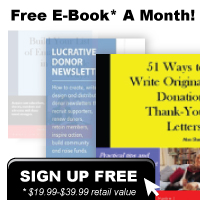Last time we looked at how to design your fundraising letter for maximum response. This time we’ll look at a few other aspects of design in the fundraising package that will help you achieve maximum response. For example…
1. If you have an element in your package with a photo or illustration, always use a caption with it. The visual will attract attention so you should take advantage of that by having a caption that relates to the photo or illustration plus builds the case for a donation. Simply, a photo or illustration without a caption is an opportunity lost.
2. Do not make the mistake of running a headline or even worse, running body copy across photos or illustrations. It reduces the effectiveness of the visual and makes the copy hard to read. Usually best to have the headline above the visual with a caption below.
3. And speaking of a lost opportunity for copy, most mailers don’t use the back of the envelope. Think about it. In order to open the envelope, you have to turn it over to get under the flap, so you spend a fair bit of time on the back. It’s a good place to write some extra copy.
4. Here’s a small tip that will help get the letter read in its entirety. It’s a tactic that takes a bit of effort but should help get the reader to turn to page two. What you do is, ensure that the first page of your letter ends in the middle of a sentence and if possible in the middle of an important thought. This forces the person to turn the page to find out how the sentence ends. One problem is that the “board” or others who must approve the letter will tell you that you shouldn’t do this. But they are the same people who tell you not to begin a sentence with “and” or “but”. And they must be reminded that they are not professional copywriters.
5. Usually we want the reader to read the letter first because it is the most powerful selling tool in the package. One way to help that to happen is to repeat the envelope copy at the top of the letter. That way, especially if the letter is nested in the envelope properly, the first thing the reader sees when they open the envelope is something familiar. They go to it and read from there as a continuation of the process that enticed them to open the envelope.
6. Here’s something that is not a “must” but is almost sure to increase response. If your budget can afford an involvement device, like a sticker, use it. It almost invariably will increase response. But it does add cost so you have to test to be sure that the increase in response pays for the increased cost.
7. Here is something to avoid – setting type in reverse (white type on a black or coloured background) when there is more than just a sentence or two. More than that and reading is too difficult. Readers hate copy set in reverse but unfortunately, designers love it and continue to use it.
8. And another thing to avoid – not having enough contrast between the type and the background. Setting blue type on a 20% blue screen background may look nice but it won’t get read. You need to have lots of contrast and best of course is black type on a white background.
9. Do not put a period at the end of a headline, even if it is a sentence. The purpose of a headline is to attract attention and motivate the reader to read more. A period is a subconscious message that says “the end” so the reader is getting a mixed message. Granted this is a very small thing but all the small things can add up to make a difference.
10. Avoid numerous type-styles and faces within your package. Some people are still smitten with the ability to use various faces and then reverse, bold, italicize or outline each one of them. Remember, the best typesetting is never noticed by the reader.
11. And finally, avoid using too small a type face in the letter or in the brochure. This is absolutely critical when your audience is older. And if you absolutely must use a small typeface because of space limitations, use a sans serif face – it is easier to read when small.




Leave a Reply